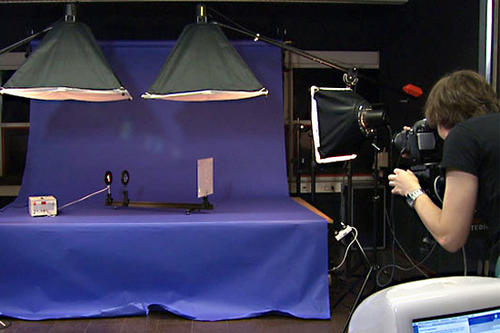Experiment 2.0
Practical experiments can be performed virtually, at flexible times and without toxic exposure, from any workstation.
Mar 22, 2010
The animation pictures of the experiment are taken in a darkroom.
Image Credit: Freie Universität Berlin / AG Nordmeier
What is good for science is not always good for people. Some experiments are hazardous to the health of pregnant women, for instance, and are therefore prohibited. That is just one group for which the Physics Education group at Freie Universität is developing its Interactive Screen Experiments (ISEs) – and has been doing so for over ten years. Just recently, they have also begun to be put into practice. The “Interactive Practical Experiments” project won distinction in the “Familie in der Hochschule” (Family on Campus) competition.
Working with a grating spectrometer, measuring the speed of light or electrical forces, observing the surface of a CD with a scanning force microscope, measuring air pressure in the elevator of a high-rise building as a function of height, depicting the spiral path of electrons within a magnetic field, or studying sunspots in the Einstein Tower, the solar observatory of the Astrophysical Institute Potsdam – these are just some examples of the many Interactive Screen Experiments (ISEs) that the Physics Education group at Freie Universität has already developed.
No Learning without Doing
The idea behind these experiments is to convey teaching content on a multimedia, interactive basis. “We want people to be able to use the ISE in a way that is similar to the experiment in real life. The user should have the sense that he or she can truly touch it and control it,” says Jürgen Kirstein, a researcher within the Physics Education group. “The ideal media that we envision are designed so that learners can handle them actively and thereby gain knowledge in a clearly laid out manner. That is the critical point: We are designing media in which it is actually impossible to learn without also doing.”
Like a Stop-motion Animated Film
Kirstein and his colleagues developed the first ISE in 1996. Since that time, the experiments have been further developed and refined on a continuous basis and adapted to new technological developments. To create the images, the real experiment is set up in the working group’s photo lab and a series of photos are taken. “Ultimately, what we are doing in the lab is the same thing that happens in an animated film. Stop-motion animation is created in the same way. The doll or model is moved gradually, and a picture is taken at every phase of the movement,” Kirstein explains. Then, Flash movies are taken as the basis for creation of interactive representations of the respective experiments, representations that can be manipulated directly using a mouse and screen.
Family Friendliness on Campus
One area in which ISEs are used is as Interactive Practical Experiments (IPEs). Previously, female students of natural sciences often had to interrupt their studies during pregnancy and while nursing because experiments that involve handling of toxic preparations are prohibited for them. The IPEs make it possible for these students to perform practical experiments virtually, at flexible times and without toxic exposure, from any workstation. In cooperation with the involved faculty, IPEs are developed in the disciplines of chemistry, veterinary medicine, biology, and physics and later provided via the learning management system of Freie Universität (Blackboard).
The project won distinction within the “Familie in der Hochschule” (Family on Campus) program, which was initiated in 2007 by the Robert Bosch Foundation, the Officer of the German Federal Government for the New Federal States within the Federal Ministry of Transport, Building and Urban Development, and the Centre for Higher Education Development (CHE) in order to improve the family friendliness of German higher education institutions. These experiments are not intended as a substitute for reality, but instead as a helpful supplement, as Kirstein says: “Certain things, like how to handle lab equipment, cannot be taught on screen. But by depicting the variety in which learned information plays a role, the IPEs represent a sensible supplement.”
Further Information
Prof. Dr. Volkhard Nordmeier
Department of Physics
Tel.: +49 (0)30 838-530 33
Email: nordmeier@physik.fu-berlin.de

